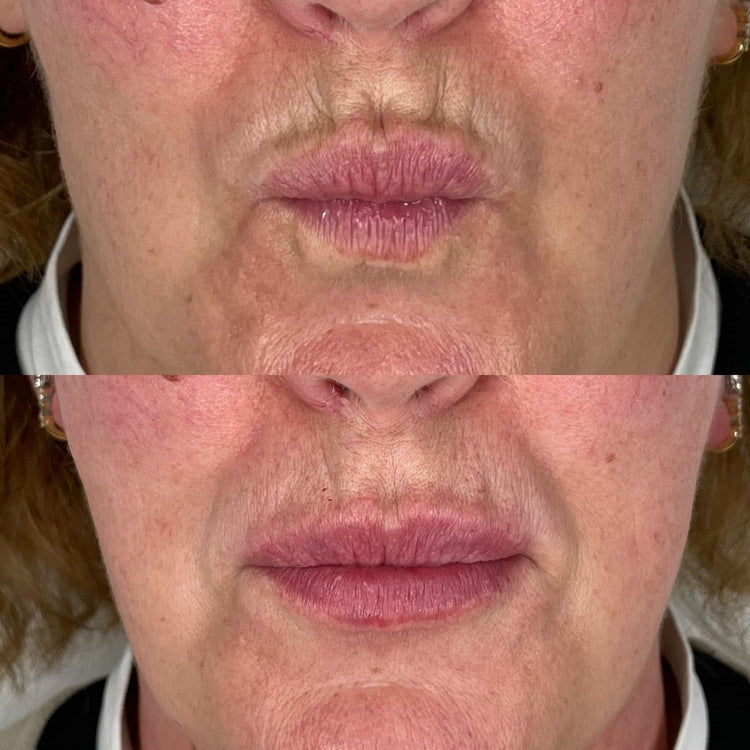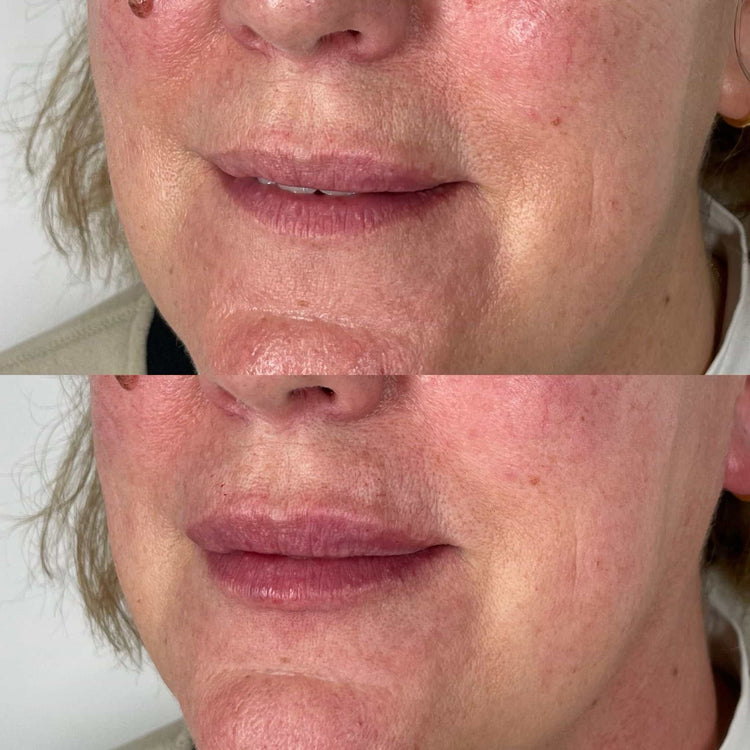The Rise of Dermal Fillers
The demand for non-surgical cosmetic procedures has skyrocketed in recent years, and dermal fillers have emerged as a leading trend in UK aesthetic medicine.
Popularity Surge
This surge in popularity can be attributed to several factors. Dermal fillers offer a relatively quick, minimally invasive, and affordable way to address signs of aging, such as wrinkles, folds, and loss of volume. Compared to surgical procedures like facelifts, fillers provide less downtime and fewer risks.
The versatility of dermal fillers also contributes to their appeal. They can be used to enhance various facial features, from smoothing forehead lines and plumping lips to defining cheekbones and restoring a youthful jawline.

Moreover, advancements in filler technology have led to safer and more effective products. Newer generations of fillers offer longer-lasting results and a smoother, more natural appearance.
Diverse Treatment Applications
The increasing popularity of dermal fillers stems from their ability to deliver noticeable cosmetic improvements without the invasiveness of surgery.
Beyond wrinkle reduction and lip augmentation, dermal fillers are increasingly used for addressing concerns like facial asymmetry, correcting acne scars, and even enhancing the shape of the nose.
Their versatility extends to body contouring treatments, where they can be used to volumize areas such as the buttocks or hands, achieving a more balanced and sculpted silhouette.
As technology continues to advance, we can expect even more innovative applications for dermal fillers in the UK aesthetic medicine landscape.
Benefits of Dermal Fillers
The demand for non-surgical cosmetic procedures has surged in recent years, with dermal fillers becoming a leading trend in UK aesthetic medicine. This popularity is driven by several factors, including their effectiveness in addressing signs of aging, affordability, minimal invasiveness, and short recovery times compared to surgical alternatives.
Addressing Signs of Aging
Dermal fillers offer a non-surgical solution for rejuvenating the appearance and addressing various concerns associated with aging. They work by injecting hyaluronic acid, a naturally occurring substance in the skin that provides volume and hydration. Fillers effectively reduce the appearance of wrinkles, fine lines, and folds by plumping up the skin and smoothing out creases.
Beyond wrinkle reduction, dermal fillers can also restore lost volume in areas like the cheeks, temples, and jawline, contributing to a more youthful and defined facial contour. They can also enhance lip fullness and shape, adding volume and definition to the lips.
Furthermore, dermal fillers can address concerns beyond wrinkles by correcting asymmetries in the face, smoothing acne scars, and even augmenting the shape of the nose non-surgically. The versatility of these treatments allows individuals to achieve a more balanced and aesthetically pleasing appearance tailored to their specific needs.
Enhancing Facial Features
Dermal fillers are transforming UK aesthetic medicine by providing a safe, effective, and minimally invasive way to enhance facial features. These injectables work by adding volume to areas where it has been lost due to aging or other factors, resulting in a smoother, more youthful appearance.
One of the most popular uses for dermal fillers is lip augmentation. They can increase lip size and fullness, define the cupid’s bow, and create a more balanced and attractive shape. Fillers can also be used to smooth out wrinkles and fine lines around the mouth, reducing the appearance of aging.
Dermal fillers are also effective in restoring volume to the cheeks, temples, and jawline. This can help to improve facial contours, making the face appear more youthful and defined. Fillers can also be used to create a more prominent cheekbone structure, adding definition to the face.
In addition to their aesthetic benefits, dermal fillers can also be used to correct certain facial asymmetries or imperfections. They can help to even out facial features, smooth acne scars, and improve the overall symmetry of the face.
Types of Dermal Fillers
The realm of UK aesthetic medicine is witnessing a remarkable transformation driven by the surging popularity of dermal fillers. These injectable treatments offer a non-surgical pathway to achieving a more youthful and aesthetically pleasing appearance.
Hyaluronic Acid Fillers
There are several types of dermal fillers, each with its own unique properties and applications. The most common type is hyaluronic acid (HA) fillers.
Hyaluronic acid is a naturally occurring substance in the body that helps to hydrate and plump up the skin. HA fillers work by attracting and retaining water molecules, effectively increasing volume and smoothing out wrinkles and folds.
There are various types of HA fillers available, each designed for specific purposes. Some HA fillers are designed for subtle volumization, while others offer more dramatic results. The longevity of HA fillers also varies depending on the formulation and individual factors.
Other types of dermal fillers include poly-L-lactic acid (PLLA) fillers and calcium hydroxylapatite (CaHA) fillers.
Calcium Hydroxylapatite Fillers
Calcium hydroxylapatite (CaHA) fillers are a type of biocompatible dermal filler made from microscopic calcium crystals suspended in a gel. These crystals stimulate collagen production, leading to gradual skin tightening and volume restoration.
CaHA fillers are known for their long-lasting results, often lasting up to 18 months or longer.
They are commonly used to address moderate to severe wrinkles, facial folds, and volume loss in areas like the cheeks, temples, and jawline.
Poly-L-Lactic Acid (PLLA) Fillers
Poly-L-lactic acid (PLLA) fillers belong to a category of dermal fillers known as stimulators. Unlike hyaluronic acid fillers that directly add volume, PLLA fillers work by triggering the body’s natural collagen production.
When injected, PLLA stimulates fibroblasts, the cells responsible for producing collagen, leading to gradual tissue thickening and skin rejuvenation. The effect is a subtle but noticeable increase in volume and firmness over time.
PLLA fillers are particularly effective for addressing deep wrinkles, facial folds, and loss of volume in areas like the cheeks, jawline, and temples.
They often provide long-lasting results, with some patients experiencing noticeable improvements for up to two years or more.
The Procedure: A Step-by-Step Guide
The demand for non-surgical cosmetic procedures has surged in recent years, with dermal fillers becoming a leading trend in UK aesthetic medicine. This popularity is driven by several factors, including their effectiveness in addressing signs of aging, affordability, minimal invasiveness, and short recovery times compared to surgical alternatives.
Consultation and Assessment
The demand for non-surgical cosmetic procedures has surged in recent years, with dermal fillers becoming a leading trend in UK aesthetic medicine. This popularity is driven by several factors, including their effectiveness in addressing signs of aging, affordability, minimal invasiveness, and short recovery times compared to surgical alternatives.
Dermal fillers offer a non-surgical solution for rejuvenating the appearance and addressing various concerns associated with aging. They work by injecting hyaluronic acid, a naturally occurring substance in the skin that provides volume and hydration. Fillers effectively reduce the appearance of wrinkles, fine lines, and folds by plumping up the skin and smoothing out creases.
- Dermal fillers can also restore lost volume in areas like the cheeks, temples, and jawline, contributing to a more youthful and defined facial contour.
- They can enhance lip fullness and shape, adding volume and definition to the lips.
- Furthermore, dermal fillers can address concerns beyond wrinkles by correcting asymmetries in the face, smoothing acne scars, and even augmenting the shape of the nose non-surgically.
Dermal fillers are transforming UK aesthetic medicine by providing a safe, effective, and minimally invasive way to enhance facial features. These injectables work by adding volume to areas where it has been lost due to aging or other factors, resulting in a smoother, more youthful appearance.
Treatment Process
Dermal fillers offer a non-surgical solution for rejuvenating the appearance and addressing various concerns associated with aging. They work by injecting hyaluronic acid, a naturally occurring substance in the skin that provides volume and hydration. Fillers effectively reduce the appearance of wrinkles, fine lines, and folds by plumping up the skin and smoothing out creases.
Dermal fillers can also restore lost volume in areas like the cheeks, temples, and jawline, contributing to a more youthful and defined facial contour. They can enhance lip fullness and shape, adding volume and definition to the lips.

Furthermore, dermal fillers can address concerns beyond wrinkles by correcting asymmetries in the face, smoothing acne scars, and even augmenting the shape of the nose non-surgically.
The versatility of these treatments allows individuals to achieve a more balanced and aesthetically pleasing appearance tailored to their specific needs.
Recovery Period
Dermal fillers offer a minimally invasive approach to addressing a range of cosmetic concerns. The procedure typically involves injecting hyaluronic acid or other gel-like substances under the skin to add volume, smooth wrinkles, and enhance facial contours.
The recovery period for dermal filler treatment is generally short. Most people can resume their normal activities immediately after the procedure.
There may be some minor side effects, such as redness, swelling, or bruising at the injection sites. These typically subside within a few days.
Safety and Side Effects
While dermal fillers offer numerous benefits, it’s crucial to understand potential side effects and prioritize safety.
Choosing a Qualified Practitioner
When considering dermal fillers, it is essential to choose a qualified practitioner with experience and expertise in aesthetic medicine. A skilled injector will assess your individual needs, medical history, and desired outcome to determine the most suitable type of filler and treatment plan.
Look for practitioners who are licensed medical professionals, such as doctors, nurses, or dentists, with specialized training in injectables.
Ensure they have a good understanding of facial anatomy and the various types of dermal fillers available.
It’s also important to inquire about their experience and track record with dermal filler treatments. You can ask for before-and-after photos of previous patients to see their work and assess their aesthetic style.
Safety should always be paramount when considering cosmetic procedures. Ensure the practitioner adheres to strict sterilization protocols and uses only FDA-approved fillers from reputable manufacturers.
Potential Risks and Complications
Dermal fillers offer a minimally invasive approach to addressing a range of cosmetic concerns. The procedure typically involves injecting hyaluronic acid or other gel-like substances under the skin to add volume, smooth wrinkles, and enhance facial contours.
The recovery period for dermal filler treatment is generally short. Most people can resume their normal activities immediately after the procedure. There may be some minor side effects, such as redness, swelling, or bruising at the injection sites. These typically subside within a few days.
While dermal fillers offer numerous benefits, it’s crucial to understand potential side effects and prioritize safety.
- Injection-site Reactions: Redness, swelling, bruising, tenderness, and itching at the injection site are common and usually temporary.
- Lumps or Bumps: These can occur if the filler is not evenly distributed. They often resolve on their own or with treatment from a qualified practitioner.
- Asymmetry: If the filler is not injected symmetrically, it can lead to an uneven appearance. It’s essential to choose an experienced injector who understands facial anatomy.
- Allergic Reactions:**
- **Vascular Occlusion (Blockage):** This is a serious complication that occurs when a filler enters a blood vessel and blocks blood flow. It can cause tissue damage or even blindness. Prompt medical attention is required if this occurs.
Although rare, allergic reactions to fillers can occur. Individuals with a history of allergies should discuss this with their practitioner before treatment.
It’s essential to choose a qualified practitioner with experience in dermal fillers.
Ask about their training, experience, and any before-and-after photos of previous patients.
Long-Term Considerations
The rise in popularity of non-surgical cosmetic procedures has led to an increasing interest in long-term solutions for facial rejuvenation. Dermal fillers have emerged as a leading trend in UK aesthetic medicine, offering the potential for lasting results and minimized downtime compared to surgical alternatives.
Filler Longevity
When considering dermal filler treatments, it’s important to understand their longevity. Different types of fillers have varying durations, typically ranging from several months to over a year.
Hyaluronic acid (HA) fillers, the most common type, generally last between 6 to 18 months.
Their longevity depends on factors like the specific HA product used, individual skin characteristics, and lifestyle factors such as sun exposure.
Poly-L-lactic acid (PLLA) fillers, which stimulate collagen production, tend to last longer than HA fillers.
Results from PLLA treatment can persist for 18 months to two years or even longer.
Calcium hydroxylapatite (CaHA) fillers also offer long-lasting results, with potential longevity of up to 18 months or more.
To maintain the desired effects and extend the longevity of dermal fillers, it’s essential to follow post-treatment instructions provided by your practitioner. This may include avoiding strenuous activities, excessive sun exposure, and certain skincare products for a specified period.
Regular touch-up appointments are generally recommended to refresh the results and maintain optimal appearance over time.
Touch-Up Treatments
Long-term considerations for dermal fillers involve understanding their longevity and the need for repeat treatments. Different types of fillers have varying durations, typically ranging from several months to over a year. Hyaluronic acid (HA) fillers, the most common type, generally last between 6 to 18 months. Poly-L-lactic acid (PLLA) fillers, which stimulate collagen production, tend to last longer than HA fillers and can persist for 18 months to two years or even longer. Calcium hydroxylapatite (CaHA) fillers also offer long-lasting results, with potential longevity of up to 18 months or more.
To maintain the desired effects, touch-up appointments are generally recommended to refresh the results and maintain optimal appearance over time. The frequency of these touch-ups will vary depending on the type of filler used, individual factors, and desired outcome.
Cost and Accessibility
The increasing popularity of dermal fillers can be attributed to their affordability compared to surgical procedures. They provide a more budget-friendly option for individuals seeking to address signs of aging or enhance their appearance without undergoing invasive surgery.
Dermal fillers are generally less expensive than surgical facelifts, brow lifts, or other procedures that aim to achieve similar results. The cost of filler treatment varies depending on factors such as the amount of product used, the areas treated, and the practitioner’s fees.
However, it is typically more affordable than surgical alternatives.
Pricing Factors
The increasing popularity of dermal fillers can be attributed to their affordability compared to surgical procedures. They provide a more budget-friendly option for individuals seeking to address signs of aging or enhance their appearance without undergoing invasive surgery.
Dermal fillers are generally less expensive than surgical facelifts, brow lifts, or other procedures that aim to achieve similar results. The cost of filler treatment varies depending on factors such as the amount of product used, the areas treated, and the practitioner’s fees.
- Cost Factors:
- Type of Filler: Different types of fillers, such as hyaluronic acid, poly-L-lactic acid (PLLA), and calcium hydroxylapatite (CaHA), have varying costs due to their ingredients, manufacturing processes, and longevity.
- Volume of Product Used: The amount of filler required for each treatment area will affect the overall cost. Larger areas or more extensive treatments naturally require more product.
- Number of Treatment Areas: If you’re addressing multiple areas, such as cheeks, lips, and forehead lines, the cost will be higher than treating a single area.
- Practitioner’s Fees: The experience, qualifications, and reputation of the practitioner can influence their pricing structure.
- Location: The cost of living and demand for aesthetic services in different geographic regions can also impact prices.
The price of dermal fillers is influenced by various factors:
It’s important to consult with a qualified practitioner to receive a personalized quote based on your individual needs and desired outcome.
Accessibility of Treatments
Dermal fillers offer an accessible solution for individuals seeking non-surgical cosmetic enhancements. Their affordability compared to surgical procedures, coupled with minimal downtime and relatively quick recovery times, makes them an attractive option for many.
While the cost of dermal fillers can vary based on factors such as filler type, volume used, and practitioner fees, they are generally more budget-friendly than surgical alternatives like facelifts or brow lifts.
To ensure accessibility, it’s important to:
- Shop Around: Compare prices from different practitioners in your area.
- Consider Financing Options: Some clinics may offer payment plans or financing options to make treatments more manageable.
- Look for Special Offers: Keep an eye out for promotions or discounts offered by clinics.
By considering these factors and exploring available options, individuals can access the benefits of dermal fillers while staying within their budget.
